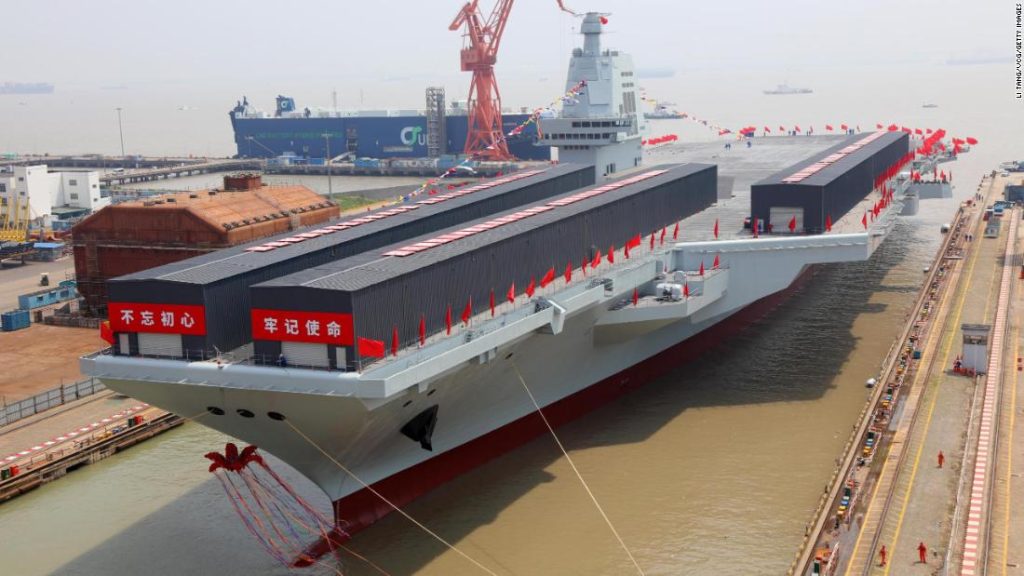Analysis: Never mind China’s new aircraft carrier, these are the ships the US should worry about

The Fujian — by far China’s biggest, most modern and most powerful aircraft carrier to date — is the 80,000-ton jewel in the crown of a military expansion that has seen Beijing grow its navy into the world’s largest.Its new combat systems — such as an electromagnetic catapult-assisted launch system — show China is fast catching up with the United States, experts say, and will give it the ability to launch more aircraft, more quickly, and with more ammunition.That should be enough to give any would-be opponent pause for thought, especially given China’s increasing aggression in its territorial disputes with Japan in the East China Sea, a host of Southeast Asian nations in the South China Sea, and its China is pushing to launch more of the super-quiet subs, which are armed with anti-ship cruise missiles, the Defense Department report said.One potent method of attack used by the Type 039 is to fire a “wake-homing” torpedo across the stern, or back, of a target vessel. The torpedo then follows in the wake of the target ship before exploding near its propulsion and steering systems. Because surface ships detect submarines and torpedoes by sound waves, wake-homing torpedoes are particularly tough to defend against.The advances in Chinese submarines come just as the US Navy is experiencing trouble with its anti-submarine capabilities.Chief of Naval Operations Adm. Michael Gilday told Congress last month that the service Crunching the numbers, said Shugart, was staggering. He estimated that using civilian ships would give China an extra 1.1 million displacement tonnes. That figure is more than three times the displacement tonnage of all of China’s amphibious assault ships put together. And if China tapped Hong Kong’s roll-on/roll-off vehicle carriers it could gain an extra 370,000 tonnes of sealift, according to Shugart.Is that enough to take Taiwan by force? That is hard to know. But Shugart said it did answer one question.”How many transport (ships) does the Chinese military have? Very probably, more than you might think.”Maritime militiaFerries aren’t the only supposedly civilian vessels military planners have on their radars.Experts also accuse China of creating a maritime militia, made up of more than a hundred vessels supposedly engaged in commercial fishing, to enforce its wishes in disputed seas.The militia — which Beijing denies even exists — is made up of at least 122 vessels and likely as many as 174, according to the Center for Strategic and International Studies.But the actual number could be even greater. Various experts suspected the militia’s involvement when more than 200 Chinese fishing boats crowded the waters around Whitsun Reef in the South China Sea in early 2021. The reef is claimed by both China and the Philippines, which described the presence of the boats as a “”The People’s Armed Forces Maritime Militia don’t fish,” Schuster told CNN last year. “They have automatic weapons aboard and reinforced hulls, making them very dangerous at close range. Also, they have a top speed of around 18-22 knots, making them faster than 90% of the world’s fishing boats.”The militia has two main parts: professional militia boats and actual fishing boats employed by the Chinese military under a subsidy scheme, according to a November report from the Asia Maritime Transparency Initiative at the Center for Strategic and International Studies (CSIS). The professionals lead such activities as harassing foreign drilling ships or blocking foreign fishing boats, and the subsidized fishers bring pressure in numbers, the CSIS report said.And with the world’s largest fishing fleet, China has plenty of reserves to call on.About that carrier againStill, none of this is to say that the launch of the Fujian is not a significant moment. As in the US, aircraft carriers will in time become the centerpiece of the PLA’s navy — and a symbol of what the modern Chinese military is capable of, Schuster said.”Fujian’s launch should be viewed for what it portends rather than its limited immediate impact,” Schuster said.”China has now launched three carriers and brought two into full operational status during a period where the US Navy has struggled to bring one new unit to full operational status,” he said.Schuster was referring to the USS Gerald Ford, a supercarrier that has been plagued by problems since its commissioning in 2017 (by which time it was already three years late).The supercarrier is yet to make its first operational deployment, though that is expected this fall.Meanwhile, China forges ahead.”They are building their navy at a faster rate than the US and all of its allies,” Schuster said.”Imperfect, but a good foundation.”






